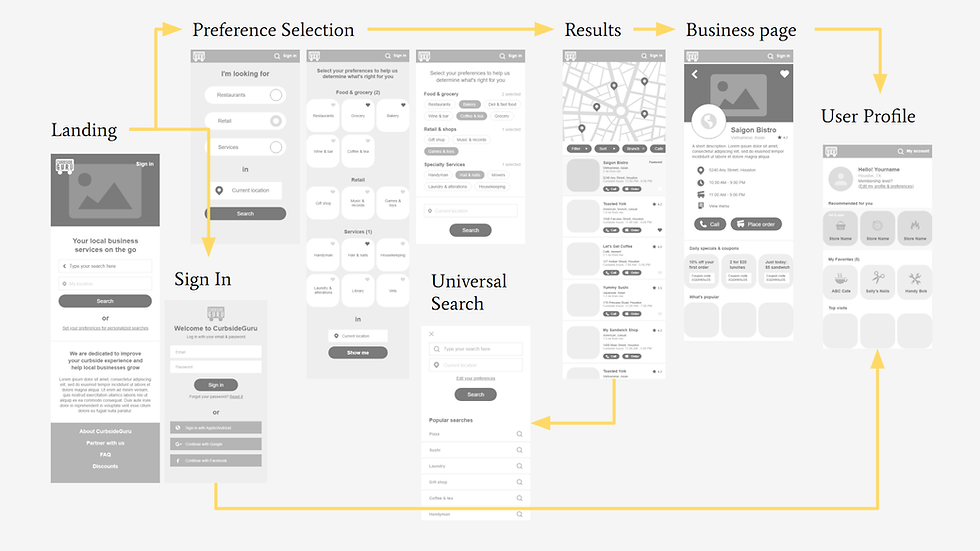Project Overview
A web platform to support small local businesses with a focus on curbside services
Designer's Role
Research, prototyping, UI designs, user testing
In the midst of the chaotic 2020, I had the chance to work on a very meaningful project intended to support small businesses that are struggling with a sharp decrease in customer visits along with a lack of digital support.
Why Supporting Small Businesses?
Here are the factors that have attributed to the birth of this idea:
Consumer behaviors have shifted dramatically during the pandemic months, online shopping has become the new norm
The sudden shift into virtual business operation has put many small businesses in a gloom, especially those who mostly obtain their revenue from in-store shopping.
Unlike the large chain-store corporations -- most small businesses do not have a sufficient amount of resource, or the right resource to help them survive a pandemic lockdown (such as online presence, web/app development, crisis management toolkit, just to name a few)
More than 99% of all businesses are small businesses, and they employ about half the US workforce. Most small businesses lack the cash reserves to weather a month-long interruption, and forecasts indicate more than 2 million workers could lose their jobs in just one week as a result of the coronavirus pandemic.
Coronavirus: Business & Economy
COVID-19 BUSINESS & ECONOMIC IMPACT TRACKER
What’s Wrong with Existing Products?
But wait, there are so many online ordering platforms available. Shouldn’t it be easy for any business to sail away on an app and live happily ever after? Well, it’s not as easy as we thought.
It turns out that third-party order apps/products take approximately 10%-30% of revenue from businesses, which does not leave the business itself with much profit when they take operational & staffing cost into account
It usually takes 1-2 weeks to transfer online revenue back to businesses which pose a critical challenge to the business’ cash flow
Introducing Curbside Guru
This is where the project owner initiated the idea for a platform that promotes curbside services, to serve convenience for customers who are opting for goods on the go, while at the same time, sustaining the livelihood of local businesses.
The platform will be free for all who join. Revenue possibilities can be further explored from a reward system, advertisements, or external support.
59% of consumers are more likely to use curbside pickup following the coronavirus outbreak.
Curbside: A win-win for retailers and consumers, alike
MVP & Initial Designs
To start it off, I quickly brainstormed the minimum viable Product features of this project and put them into designs.

Fundamental Functionality
Auto locate
Recommend/+new for quick user growth
Platform interactions: register, browse & rate
Reward system? Donation receipt?
Revenue Source
Banner ad space for special promotions or sponsorship
$1 - $2 charged per order if payment processed through CG
PR/crisis/legal management
Wireframing
While designing the wireframes, I purposely turned the first critical search step into 3 distinctively different designs with the goal to receive instinctive feedback from users to tell me which way works the best.
The first set of wireframes are abstract without too much detailed content. It mapped out the most important steps in the bare minimum, which helped the testing participants to focus on the sole purpose of each step, and help me fill in the blanks in places needed.

Results from User Testing
Every testing participant unanimously leaned toward preference setting No.3, feeling this format displays the maximum about of information under one glance, and it doesn’t require users to categorize the content by themselves or take a second guess
Pick-up instructions will need to be displayed for customers who have placed their orders through the platform
Users who are looking for food/restaurants (order > grab > go) may experience a different journey than users looking for services (quote > compare > request service)
Review System: the Constant Battle
A rating or review system becomes unavoidable in the world of an online presence. It’s a constant love-and-hate relationship that never seems to get resolved.
As I tested the wireframes, it turns out that users have mixed reactions toward review/rating systems, most are used to the impression of stars or points; reading others’ comments can sometimes be beneficial, and other times be misleading. In the end, there is no perfect rating system that does everyone justice.

Especially for small businesses that have not generated much online visitor traffic yet, all it takes is one bad review to crush their reputation. It’s often hard to tell the origin of the negativity. Sometimes it was the business itself that offered less-than-satisfactory service or goods, sometimes it was a customer who just had a bad day and bashed at the business at the wrong place and wrong time.
In order to help the customers see a more “justified” picture of every business, I thought about a system that separately rates the staff aside from the merchandise. That way one accidental human error will not put the overall image of the business at risk, or vice versa.
What Happens if Nothings Shows Up?
I also took note of what would have happened if a user ends up getting nothing from search results, which could very likely happen at the platform’s initial launching stage. Can users “recommend” a business they see in exchange for a small reward while helping the network itself grow?
Iteration & Improvement
The designs were then produced in high-fidelity format. The visuals became closer to a real product, with the noted iterations implemented.

Current Status
The project is now awaiting feedback from small business owners who qualify as potential users.







Comments